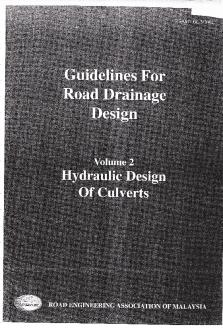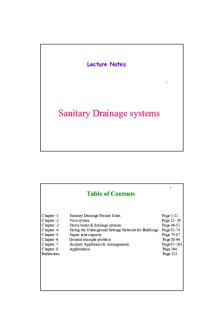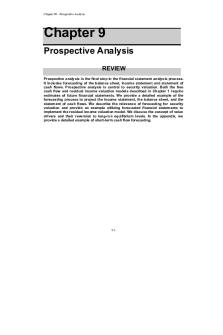Manual Road Drainage Chapter 9 PDF

| Title | Manual Road Drainage Chapter 9 |
|---|---|
| Course | Civil Eng Design Project |
| Institution | Griffith University |
| Pages | 51 |
| File Size | 2.1 MB |
| File Type | |
| Total Downloads | 38 |
| Total Views | 126 |
Summary
Manual Road Drainage Chapter 9...
Description
Department of Transport and Main Roads Road Drainage Manual
Chapter 9 Culvert Design
Chapter 9 Culvert Design
9
January 2013
i
Department of Transport and Main Roads Road Drainage Manual
Chapter 9 Culvert Design
Chapter 9 Amendments – Jan 2013 Revision Register Issue/ Rev No.
Reference Section
1
-
2
9.2.1, 9.2.6, 9.7.2, 9.7.3, 9.15 & 9.16
9
January 2013
ii
Description of Revision
Initial Release of 2nd Ed of manual. Minor update. Incorporation of Planners & Designers Instruction No:7. New Appendix 9D & 9E.
Authorised by
Date
Steering Committee
Mar 2010
M Whitehead
Jan 2013
Department of Transport and Main Roads Road Drainage Manual
Chapter 9 Culvert Design
Table of Contents 9.1
9.2
Introduction
9-1
9.1.1
Overview
9-1
9.1.2
Constructability
9-2
9.1.3
Computer Programs
9-2
General Requirements
9-2
9.2.1
Pipe Joint Types
9-2
9.2.2
Geometric Tolerances and Cover Requirements
9-3
9.2.3
Skew Angle / Skew Number
9-3
9.2.4
Minimum Culvert Size
9-3
9.2.5
Outlet Flow Velocity
9-3
9.2.6
Structural and Configuration Requirements of Culverts
9-4
9.2.7
Culverts in Expansive Soil Areas
9-10
9.2.8
Flap Gates (Tides and Floods)
9-16
9.2.9
Multiple Barrels
9-17
9.2.10
Reduction in Culvert Size
9-17
9.2.11
Splay Pipes
9-17
9.3
General Process for Culvert Design
9-18
9.4
Location of Culverts
9-20
9.5
Allowable Headwater
9-21
9.6
Preliminary Selection of Culvert Size
9-22
9.7
Requirements for Fauna Passage
9-22
9.7.1
Considerations for Fish Passage
9-22
9.7.2
Culvert Specifications for Fish Passage
9-22
9.7.3
Considerations for Terrestrial Passage
9-24
9.7.4
Culvert Features for Fauna Passage
9-24
9.7.5
Stock Underpass
9-26
9.8
Selection of Culvert Type
9-26
9.9
Typical Culvert Operating Conditions
9-27
9.9.1
Inlet Control Conditions
9-29
9.9.2
Outlet Control Conditions
9-29
January 2013
iii
9
Department of Transport and Main Roads Road Drainage Manual
9.10
9.11
Hydraulic Calculations
Chapter 9 Culvert Design
9-29
9.10.1
Control at Inlet
9-29
9.10.2
Control at Outlet
9-30
9.10.3
Determination of Tailwater
9-33
Design Procedure
9-33
9.11.1
Hydraulic Design
9-33
9.11.2
Practical Design
9-40
9.12
Minimum Energy Loss Culverts
9-40
9.13
Blockage of Culverts
9-41
9.14
Consideration of Large or Extreme Events
9-42
9.15
Culvert Outlet Protection
9-42
9.16
Special Energy Dissipation Structures at Culvert Outlet
9-45
9.17
‘Self Cleaning’ Culverts
9-45
9.18
Inlet Structures
9-45
9.19
Managing Sediment
9-45
9.20
Safety
9-46
9.20.1
Culverts Used As Walkways and Bikeways
9-46
9.20.2
Barriers to Flow
9-46
9.20.3
Additional Safety Considerations
9-46
9
9
January 2013
iv
Department of Transport and Main Roads Road Drainage Manual
Chapter 9 Culvert Design
Chapter 9 Culvert Design 9.1
Introduction
9.1.1
Overview
Culverts are important hydraulic structures used to convey water across a road corridor or in one of a range of other situations. Culverts must be designed to convey this flow in an acceptable way, considering the hydraulic conditions and the required performance (level of flood immunity) of the road. Environmental and/or other requirements may also need to be considered / incorporated depending on the specific circumstances. In particular, the provision of fauna passage, including fish movement, may need to be incorporated into the design. In certain situations (typically where specified by an environmental assessment document), culvert designs will have special requirements to allow the passage of fish or terrestrial fauna. Other uses for culvert structures may include pedestrian / cyclist movement, vehicular movement (including rail / cane rail), fauna crossing or stock underpass. While the requirements will differ depending on whether passage is to be catered for, all will require a clear distinction between wet and dry passageways. The size requirements for passage as well as hydraulic requirements need to be considered and the culvert sized appropriately to meet both of these requirements.
If no passage is to be provided, then the culvert is designed solely for hydraulic purposes. Hydraulic design of culverts is often an iterative process. As such, while the layout of this chapter reflects a typical order of design, this will not always be the case. In many instances it may be necessary to revisit steps in the design process. Section 9.3 sets out a general process for the design of the culverts while Sections 9.10 and 9.11 provide more detail. The process adopted is considered as industry practice and while a simplified process, it is appropriate for most culverts designs. Changes may arise for technical or nontechnical reasons, and hence a clear record of the decision making process should be retained at all times. Procedures for assessing the erosion potential and control at the inlet and outlets of culverts are included as part of the culvert design process. In some cases, hydraulic structures for permanent erosion control may be required with the design of culvert inlet and outlet structures and energy dissipaters considered. In some locations, the design will be complex and beyond the methods presented in this chapter. In this instance, computer model development, simulation and testing may assist in design and the designer should contact the Director (Hydraulics), Hydraulics Section, Engineering & Technology Division for further guidance.
January 2013
9-1
9
Department of Transport and Main Roads Road Drainage Manual
9.1.2
Chapter 9 Culvert Design
Constructability
When designing culverts, construction and future maintenance requirements must be considered with appropriate treatments incorporated into the design. Some guidance with respect to construction requirements and methods can be found within various departmental standard drawings and specifications. However, this must not prevent all hydraulic and environmental requirements from being satisfied. Relevant standard drawings for culverts are: 1131, 1132, 1145, 1148, 1174, 1179, 1284, 1303, 1304, 1305, 1306, 1316, 1317, 1318, 1319, 1320 and 1359 (QDMR 2009b). The main departmental specifications are MRTS03 and MRTS04 (TMR 2010c). For any possible non-standard or complicated culvert configurations, it is highly recommended that designers should involve construction personnel early in the design process to provide site specific construction / constructability advice.
chainage, skew number, invert heights, culvert component details (including joint type), quantities of precast components and installation materials, hydraulic design details; and incorporates the culvert model into the project electronic model within the 12d Model™ application. As with all tools, use of this computer program will require output to be checked and verified. As a quick check, the head loss through a culvert is typically around 1.4 to 1.7 times the velocity head. Alternatively, review the design charts provided in this chapter (and appendices) or perform a quick manual calculation.
9.2
General Requirements
9.2.1
Pipe Joint Types
There are three types of joints for reinforced pipes: Flush or Butt Joint;
9.1.3
9
Computer Programs
With reference to Section 1.2.2.5, the department requires the use of the CULVERT software to hydraulically design culverts and model them within the 12d Model™ application. The reasoning for this requirement is that the software: performs the hydraulic design of cross road drainage consistent with practice detailed in this chapter; provides records of the culvert design; produces the drawing of the designed drainage cross section to departmental standards, i.e. showing
January 2013
9-2
Rubber Ring Joint / Spigot and Socket; and Jacking. Designers should choose the most appropriate joint type for each installation. Flush or Butt Joint pipes are best suited where ground movement is not expected. They are an economical option but installations require a high level of compaction where the resulting soil envelope is extremely stable. Rubber Ring Joint / Spigot and Socket type pipes allow for ground movement more than flush joint pipes and should generally be used for all sizes of pipe in unstable
Department of Transport and Main Roads Road Drainage Manual
Chapter 9 Culvert Design
ground, when pipes are laid in sand, or where pipe movement is possible, such as on the side of fills or at transitions from cut to fill. This type should also be used where the normal groundwater level is above the pipe obvert.
Skew Number
Jacking pipes are used where conventional excavation / laying / backfill methods are not feasible. Designers should refer to manufacturer’s guidelines for selection, use and design detail for jacking pipes.
9.2.2
Geometric Tolerances and Cover Requirements
The geometric tolerances for location / position of culverts and minimum cover requirements will be as specified in the drawings or as per the department’s specification MRTS03 (TMR 2010c).
9.2.3
Skew Angle / Skew Number
As per MRTS01 (TMR 2010c), the determination of the ‘Skew Angle’ and/or ‘Skew Number’ for a skewed culvert installation is shown in Figure 9.2.3. These terms are used to specify the horizontal orientation of skewed culvert structures relative to the road centre line. The skew number is the number of degrees measured in a clockwise direction from the road centreline to the structure centreline. Skew Number is required for ordering metal structures.
Figure 9.2.3 Skew Number / Skew Angle
9.2.4
Minimum Culvert Size
The minimum diameter of any pipe culvert shall be 375 mm. The minimum waterway dimension (height) of any box section shall be 375 mm, however in constrained situations and where all reasonable attempts to fit a 375 mm high box section have failed, a minimum 300 mm high box culvert can be used.
9.2.5
Outlet Flow Velocity
The calculation of outlet velocity is required for every culvert, and the type and extent of protection should be decided after consideration of the outlet velocity, the natural downstream ground conditions, the natural stream velocities, and the performance of existing culverts in the area. High outlet velocities can cause erosion for a significant distance downstream of an outlet. Where high outlet velocities are expected, appropriate dissipation and/or protection measures will be required. Where possible, culverts should be designed to provide acceptable velocities without the need for additional channel protection. Allowable velocities to avoid
January 2013
9-3
9
Department of Transport and Main Roads Road Drainage Manual
scour vary according to soil type and topography.
unit strength (for example, pipe class);
Table 9.2.5 provides some target culvert outlet velocities for various channel materials. These target velocities must be verified / amended by data gathered from site inspections and relevant environmental reports.
type of bedding and backfill material; and pipe diameter culverts).
(excluding
box
Table 9.2.5 – Target Culvert Outlet Velocities Material Target Outlet Downstream of Velocity (m/s) Culvert Outlet
The following specifies the requirements with respect to the determination of design loadings for buried structures and selection of correct pipe class, based on the department’s technical specification MRTS25 (TMR 2010c).
Rock
4.5
(a) Determination of Design Loads
Stones 150 mm diameter or larger
3.5
Gravel 100 mm or grass cover Firm loam or stiff clay
2.5
Sandy or silty clay
1.2 - 2.0 1.0 – 1.5
Source: derived from Austroads GRD Part 5 (2008)
9.2.6
Structural and Configuration Requirements of Culverts
Loads on buried culverts include:
9
Chapter 9 Culvert Design
(a) Fill over the structure, which is a function of: height of fill type of fill material installation conditions (e.g. ‘trench’ or ‘embankment’) (b) Design traffic loads; (c) Construction traffic loads; and (d) Other or abnormal load conditions. The load bearing capacity of a culvert is a function of:
January 2013
9-4
The methodology, to determine the design loads on a culvert is specified in Clause 6 of AS3725. With reference to Clause 6.5.3.3 of AS3725, the calculated distribution of working loads shall comply with the requirements as specified in AS5100.2. For uniformity, the department has adopted AS5100.2 to provide the design criteria for loads on all buried structures. The load distribution ratio is to be in accordance with Clause 6.12 of AS5100.2. It is important to note that (for departmental projects) Table B2 of AS3725 is not accepted as it is based on a load distribution ratio which is not in accordance with AS5100.2. At the time of issue all known pipe load and class determination software available from various companies and associations, do not use the TMR accepted load distribution ratio. This software must not be used until a proof of change can be verified by Structures Branch within Engineering & Technology. Design loadings need to be determined for SM1600 and HLP400 loads. Table 4-A of MRTS25 shows correct live load pressures (as it is based on AS5100.2) for W80 wheel load.
Department of Transport and Main Roads Road Drainage Manual
Chapter 9 Culvert Design
(b) Determination of Pipe Class
coatings. Refer Section 9.2.6.8 for more details.
The design load, as determined above, becomes the proof load for using Table 4.2 of AS4058 to determine the required pipe class. It is important to note that civil designers are restricted to specifying culverts up to and including Class 10 pipes. Any situation or requirement to use higher class pipes must be reviewed and approved by Structures Branch. (c) Support Types The department generally specifies either H2 or HS3 support types - refer AS3725, Standard Drawing 1359 (QDMR 2009b) and Section 9.2.6. Other support types can be used, however the use of these types be fully detailed and specified in the project’s documents as they are not covered by the department’s Standard Specifications and/or Drawings.
9.2.6.1 Structural Requirements for New Structures The design life for all culvert types is now 100 years. The following departmental specifications (TMR 2010c) apply to culvert components: MRTS24 – For concrete box culvert components; MRTS25 – for precast concrete pipe components; MRTS26 - for fibre reinforced pipe components; and MRTS29 – for polyethylene and polypropylene pipe components. Steel culvert components do not currently have an applicable departmental specification and do not meet the 100 year design life requirement without protective
9.2.6.2 Structural Requirements for Existing Structures The road network is increasingly subjected to vehicles carrying heavy loads and therefore planners and designers must consider the freight task for the road link. Bridges and culverts designed since 2004 are in accordance with AS5100 which has SM1600 design loads and HLP 400 vehicles. Bridges and culverts that were designed and constructed prior to 2004 do not have a design loading capability equivalent to current design loads. Of particular concern are pre-2004 culverts that are subject to critical loading, such as structures that have less than 2 metres of cover (including pavement layers). These structures may influence the freight task capability of the road link in which they are located and should be considered for replacement if they cannot support the anticipated future loads. Specifically, pre-cast and cast-in-situ culverts purchased or placed in the road network before 1976, were designed for significantly lighter loads and may also be past their design life (which was typically 50 years). This means that pre-1976 culvert structures on the road network with less than 2 metres of cover are likely to be subjected to repetitive and/or peak loadings that exceed the structural capacity of the aged culvert structure. This reduces their service life and greatly increases the risk of structural failure. While critical loading is less of an issue for all culverts with two or more metres of cover, dead loads can be. These structures should also be inspected and replaced if found deficient.
January 2013
9-5
9
Department of Transport and Main Roads Road Drainage Manual
The following requirement (policy) is not intended as a network management tool or guide and should only be applied on a project by project basis.
9
For all planning, design and construction projects (excluding non-drainage related routine maintenance and sprayed reseals) it is strongly recommended that no pre-1976 culvert be retained. Retaining any pre-2004 culverts, including pre-1976 culverts, is an action that will potentially extend the service life of the culvert (or parts of it; e.g. centre units of culvert extensions) beyond its design life and placing the structure at greater risk of failure. Therefore each pre2004 structure to be retained, must undergo the ‘Structural Assessment / Decision Process’ as shown in Appendix 9D. While this process applies to all culvert structures, major culverts (as defined in the departm...
Similar Free PDFs
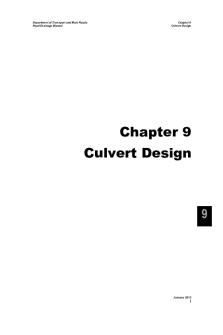
Manual Road Drainage Chapter 9
- 51 Pages

URBAN DRAINAGE DESIGN MANUAL
- 478 Pages

Solution Manual chapter 9
- 174 Pages

Chapter - 9 (Manual)
- 44 Pages

Drainage
- 7 Pages
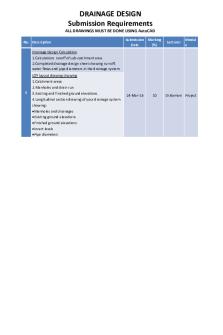
Drainage Design
- 43 Pages

9 - Chapter 9
- 26 Pages

Lab Manual 9 Cantilever
- 3 Pages

Chapter 9 quiz #9
- 3 Pages
Popular Institutions
- Tinajero National High School - Annex
- Politeknik Caltex Riau
- Yokohama City University
- SGT University
- University of Al-Qadisiyah
- Divine Word College of Vigan
- Techniek College Rotterdam
- Universidade de Santiago
- Universiti Teknologi MARA Cawangan Johor Kampus Pasir Gudang
- Poltekkes Kemenkes Yogyakarta
- Baguio City National High School
- Colegio san marcos
- preparatoria uno
- Centro de Bachillerato Tecnológico Industrial y de Servicios No. 107
- Dalian Maritime University
- Quang Trung Secondary School
- Colegio Tecnológico en Informática
- Corporación Regional de Educación Superior
- Grupo CEDVA
- Dar Al Uloom University
- Centro de Estudios Preuniversitarios de la Universidad Nacional de Ingeniería
- 上智大学
- Aakash International School, Nuna Majara
- San Felipe Neri Catholic School
- Kang Chiao International School - New Taipei City
- Misamis Occidental National High School
- Institución Educativa Escuela Normal Juan Ladrilleros
- Kolehiyo ng Pantukan
- Batanes State College
- Instituto Continental
- Sekolah Menengah Kejuruan Kesehatan Kaltara (Tarakan)
- Colegio de La Inmaculada Concepcion - Cebu
